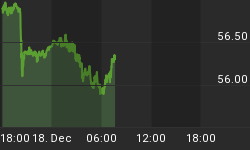In our articles titled "Silver ETF: Shock & Awe" and "Powerful Silver ETF", we highlighted how the introduction of a silver ETF would send shockwaves through the financial markets. We used the introduction of the U.S. gold ETFs (tickers: GLD & IAU) as a model of what would happen to physical silver demand once the silver ETF (proposed ticker: SLV) starts trading on the Amex. Now that a little more than one year has passed since the gold ETFs were introduced, let's take another look at just how much demand for silver could be impacted.
In their first twelve months of trading, GLD & IAU (the two gold ETFs) accumulated well over 7 million ounces of gold in their vaults. Then, in the following three months, an additional 3 million ounces have poured in. At $558/oz, this means that nearly $6 billion of new demand has been created by the two U.S. gold ETFs over their first fifteen months. Some shifting from physical bullion to the ETFs may have occurred, but near as we can tell, it has been negligible as most of the demand created by the ETFs is truly new.
If silver, through its ETF, can add over time in dollar demand what GLD & IAU did in just 15 months, we are talking about an additional 600+ million ounces being taken off the world market. With silver trading at around $9.60/oz, $6 billion in incremental investment demand would translate more precisely into about 625 million ounces of the grey metal. This would almost certainly wipe out the entire world's identifiable supply of above ground silver (about 550 million ounces according GFMS). Is it any wonder why the SUA (Silver User's Association) is trying to cry "uncle" to the SEC in the hopes of putting the kibosh on the silver ETF?
Now before you back up the truck and start hoarding silver bars, please realize that we do not expect 600+ million ounces to be sucked up anytime soon as a result of the silver ETF. Furthermore, we are skeptical that GFMS is able to pin down the above ground silver supply at 550 million ounces when there could theoretically be large unknown amounts of silver sitting in China and India and/or private hoards.
With all that said, we do think the 500-600 million ounces in relatively easily liquidated above ground ounces is a conservative place to start for liquid silver inventories. The real question then becomes how much silver is likely to be consumed over the next year or two by the impending silver ETF which, thanks to recent rumblings by Barclays and Amex, appears closer to getting approved by the SEC.
Below we have built a ballpark estimate of what we think is possible in silver ETF demand over its first 15 months:

Although this is mainly guesswork, our conclusion is that 76 million ounces give or take a few million ounces is a reasonable conservative estimate for silver demand over its first 15 months. To arrive at this estimate, we have simply taken the U.S. gold ETF market capitalization of a shade under $6 billion and divided it by the annual $68 billion of total gold demand. This works out to about 8.7% of annual gold demand having been diverted into U.S. gold ETF vaults in the last 15 months. Assuming the silver ETF were to attract the same percentage of ETF demand versus annual total silver demand, that would equate to the silver ETF reaching a market capitalization of about $736 million in 15 months or, at today's prices, about 76 million ounces of silver.
Considering that total silver investment demand was estimated in 2004 at only about 40 million ounces, an incremental 76 million ounces could have a profound positive impact on silver as it would eliminate at least 15% of the world's identifiable above ground supply in what is already a very tight market.
Finally, if you were to ignore all of our ETF demand assumptions and look at the big picture, you should be even more bullish. The fact is that the entire dollar value of annual silver demand is peanuts. If SLV approaches anything close to the popularity of the other ETFs, then silver's run-up may be more spectacular than anyone can imagine.















